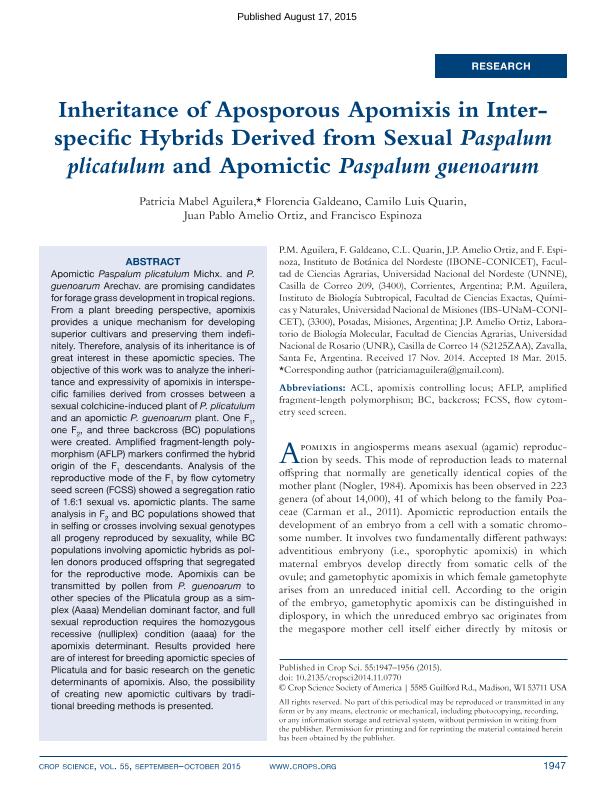Mostrar el registro sencillo del ítem
dc.contributor.author
Aguilera, Patricia Mabel

dc.contributor.author
Galdeano, Florencia

dc.contributor.author
Quarin, Camilo Luis

dc.contributor.author
Ortiz, Juan Pablo Amelio

dc.contributor.author
Espinoza, Francisco

dc.date.available
2016-02-10T20:23:46Z
dc.date.issued
2015-09
dc.identifier.citation
Aguilera, Patricia Mabel; Galdeano, Florencia; Quarin, Camilo Luis; Ortiz, Juan Pablo Amelio; Espinoza, Francisco; Inheritance of Aposporous Apomixis in Interspecic Hybrids Derived from Sexual Paspalum plicatulum and Apomictic Paspalum guenoarum; Crop Science Soc Amer; Crop Science; 55; 5; 9-2015; 1947-1956
dc.identifier.issn
0011-183X
dc.identifier.uri
http://hdl.handle.net/11336/4119
dc.description.abstract
Apomictic Paspalum plicatulum Michx. and P. guenoarum Arechav. are promising candidates for forage grass development in tropical regions. From a plant breeding perspective, apomixis provides a unique mechanism for developing superior cultivars and preserving them indefinitely. Therefore, analysis of its inheritance is of great interest in these apomictic species. The objective of this work was to analyze the inheritance and expressivity of apomixis in interspecific families derived from crosses between a sexual colchicine-induced plant of P. plicatulum and an apomictic P. guenoarum plant. One F1, one F2, and three backcross (BC) populations were created. Ampli!ed fragment-length polymorphism (AFLP) markers confirmed the hybrid origin of the F1 descendants. Analysis of the reproductive mode of the F1 by fow cytometry seed screen (FCSS) showed a segregation ratio of 1.6:1 sexual vs. apomictic plants. The same analysis in F2 and BC populations showed that in sel!ng or crosses involving sexual genotypes all progeny reproduced by sexuality, while BC populations involving apomictic hybrids as pollen donors produced offspring that segregatedfor the reproductive mode. Apomixis can be transmitted by pollen from P. guenoarum to other species of the Plicatula group as a simplex (Aaaa) Mendelian dominant factor, and full sexual reproduction requires the homozygous recessive (nulliplex) condition (aaaa) for the apomixis determinant. Results provided here are of interest for breeding apomictic species of Plicatula and for basic research on the genetic determinants of apomixis. Also, the possibility of creating new apomictic cultivars by traditional breeding methods is presented.
dc.format
application/pdf
dc.language.iso
eng
dc.publisher
Crop Science Soc Amer

dc.rights
info:eu-repo/semantics/openAccess
dc.rights.uri
https://creativecommons.org/licenses/by-nc-sa/2.5/ar/
dc.subject
Crop Genetics
dc.subject
Other Forage Crops
dc.subject
Apospory
dc.subject
Interspecific Hybrids
dc.subject
Flow Cytometry
dc.subject.classification
Agronomía, reproducción y protección de plantas

dc.subject.classification
Agricultura, Silvicultura y Pesca

dc.subject.classification
CIENCIAS AGRÍCOLAS

dc.title
Inheritance of Aposporous Apomixis in Interspecic Hybrids Derived from Sexual Paspalum plicatulum and Apomictic Paspalum guenoarum
dc.type
info:eu-repo/semantics/article
dc.type
info:ar-repo/semantics/artículo
dc.type
info:eu-repo/semantics/publishedVersion
dc.date.updated
2016-03-30 10:35:44.97925-03
dc.journal.volume
55
dc.journal.number
5
dc.journal.pagination
1947-1956
dc.journal.pais
Estados Unidos

dc.journal.ciudad
Baltimore
dc.description.fil
Fil: Aguilera, Patricia Mabel. Consejo Nacional de Investigaciones Científicas y Técnicas. Centro Científico Tecnológico Nordeste. Instituto de Biología Subtropical. Instituto de Biología Subtropical - Nodo Posadas; Argentina. Consejo Nacional de Investigaciones Científicas y Técnicas. Centro Científico Tecnológico Nordeste. Instituto de Botánica del Nordeste (i); Argentina
dc.description.fil
Fil: Galdeano, Florencia. Consejo Nacional de Investigaciones Científicas y Técnicas. Centro Científico Tecnológico Nordeste. Instituto de Botánica del Nordeste (i); Argentina
dc.description.fil
Fil: Quarin, Camilo Luis. Consejo Nacional de Investigaciones Científicas y Técnicas. Centro Científico Tecnológico Nordeste. Instituto de Botánica del Nordeste (i); Argentina
dc.description.fil
Fil: Ortiz, Juan Pablo Amelio. Consejo Nacional de Investigaciones Científicas y Técnicas. Centro Científico Tecnológico Nordeste. Instituto de Botánica del Nordeste (i); Argentina. Universidad Nacional de Rosario. Facultad de Ciencias Agrarias. Laboratorio de Biología Molecular; Argentina
dc.description.fil
Fil: Espinoza, Francisco. Consejo Nacional de Investigaciones Científicas y Técnicas. Centro Científico Tecnológico Nordeste. Instituto de Botánica del Nordeste (i); Argentina
dc.journal.title
Crop Science

dc.relation.alternativeid
info:eu-repo/semantics/altIdentifier/url/http://dx.doi.org/10.2135/cropsci2014.11.0770
dc.relation.alternativeid
info:eu-repo/semantics/altIdentifier/url/https://dl.sciencesocieties.org/publications/cs/abstracts/55/5/1947
dc.relation.alternativeid
info:eu-repo/semantics/altIdentifier/issn/0011-183X
Archivos asociados
